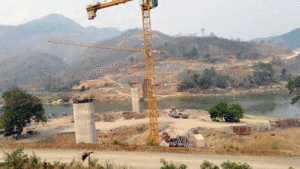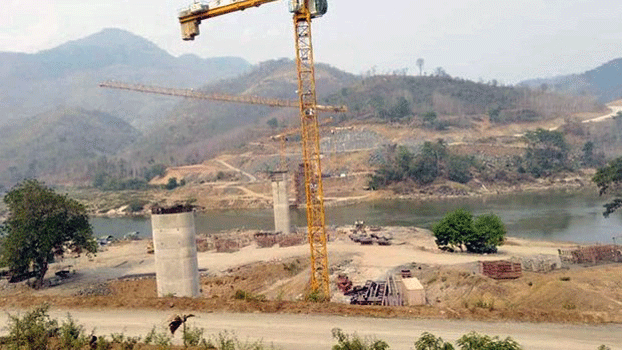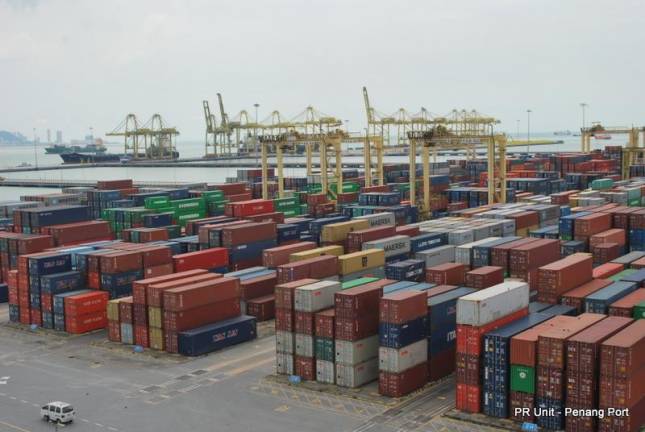
Photo courtesy of a citizen journalist
Laos Pushes Ahead With Large Dam Projects Despite Uncertainty of Thailand’s Power Purchases
Thailand, the major buyer of Lao power, says decision will turn on need, industrial production, and prices.
The Lao government is pushing ahead with more hydroelectric dams despite uncertainty about Thailand’s willingness to purchase the electricity they generate, Lao officials and others with knowledge of the situation said.
Laos has 78 dams in operation and has signed memorandums of understanding for 246 other hydroelectric projects in its quest to become the “battery of Asia” that exports electricity to neighboring countries, primarily Thailand.
But Thailand has not yet decided whether to buy additional power generated by new dam projects from Laos and may not sign agreements to purchase electricity from four major planned Mekong River dams — the Luang Prabang, Sanakham, Pak Lay, and Pak Beng dams, the Electricity Generating Authority of Thailand (EGAT) told RFA in an Aug. 26 email.
“The decision to buy or not to buy power from Laos depends on the need of Thailand, the [industrial] production in Thailand and prices,” EGAT said.
The Thai National Energy Policy Commission under the Ministry of Energy confirmed that it has not signed any power purchase agreements (PPAs) from the four dam projects, said Chalermsri Prasertsri, an attorney from the Community Resources Center and a representative of the Thai Mekong People’s Network from Eight Provinces, comprised of people who live by the Mekong River.
“We’re opposed to the plan — more specifically the plan to purchase power from Pak Beng, Pak Lay, Luang Prabang and Sanakham dams in Laos,” she told RFA on Aug. 27.
The network previously has cited transboundary environmental impacts of such projects, including fluctuations in the water level of the Mekong, the disruption of seasonal fish migration, and a lack of sedimentation.
Additionally, EGAT said it would include a condition in the future PPAs that dam developers must be responsible for any environmental and social impacts in Thailand created by the dams, she said.
Witoon Permpongsacharoen, director of the Mekong Energy and Ecology Network, said that new PPAs were not necessary because Thailand’s energy reserves are so large that it must review all contracts.
But an official from the Lao Ministry of Energy and Mines, who requested anonymity because he was not authorized to speak to the media, told RFA that the Lao government had not received a formal notice from the Thai Energy Ministry indicating that officials were not going to sign PPAs from the four Lao dams.
“Now, Thailand is still our number-one market and a good customer,” he said.
“If Thailand doesn’t buy electricity from those four dams, we’ll sell it to China, Vietnam, and Cambodia,” said the official.
In early August, Lao government proposed to sell 1,200 megawatts (MW) of electricity to Thailand in addition to an existing 9,000 MW, he said.
“Right now, the two sides are in the process of negotiating,” he said.
Laos has the potential to produce up to 28,000 MW of power in 2030.
Luang Prabang Dam
Some observers are questioning the wisdom of Laos continuing its dam-building program in light of the environmental and social impacts of past projects as well as the frequency of flood disasters, some of which have killed people.
Earlier this year, Xaysomphone Phomvihanh, president of the Lao National Front for Construction, said the Luang Prabang Dam project, scheduled for completion in 2027, is one of the most important government development projects, the Lao Economic Daily reported in March.
But he urged the dam developer Ch. Karchang Public Company Ltd., to be mindful of the project’s impact on environment and local people. The Thai construction company also built the Xayaburi Dam, Laos’ first mainstream Mekong hydropower project that came under fire for its social and environmental effects.
UNESCO’s World Heritage Committee has called for the Luang Prabang Dam project to be suspended until a heritage impact assessment (HIA) can be completed, Monthira Unakul, a culture and arts expert at UNESCO’s Thailand office, told RFA on Tuesday.
The well-preserved ancient capital of Luang Prabang in the northern Laos’ province of the same name, known for its many Buddhist temples and monasteries, is situated in a valley at the confluence of the Mekong and Nam Khan rivers.
The 7th-century city, which has been a major center of tourism — a sector which brought in U.S. $900 million a year before the 2020 pandemic shutdown — was declared a World Heritage Site by UNESCO in 1995.
“The World Heritage Committee made the decision in July this year that the construction of the Luang Prabang Dam should be suspended until the HIA has been done,” Monthira Unakul said.
The committee wants a study on the impact of the dam on the World Heritage Site to be completed and reported to it by Feb. 1, 2022, she said.
Monthira Unakul said she was aware that construction on the dam had not yet begun, although access roads to the site and other project infrastructure have already been built.
Raweewan Bhuridej, secretary of the Thai National Committee for the Protection of the World Heritage Sites, told RFA on Tuesday that Laos had received U.S. $70,000 from the World Heritage Fund and the Chinese government to conduct the HIA.
Laos “has to look at all impacts and risk factors on which the design will be based on,” she said. “Then, the report of the study should be sent to the World Heritage Center for further consideration.”
The Lao government is gathering data on the potential impact of the Luang Prabang Dam on the World Heritage Site, said an official at the Lao Ministry of Information, Culture and Tourism, who declined to be named in order to speak freely.
“Yes, we’re discussing the process with the World Heritage Center, and we’re filing a report with our government,” he said. “The relevant departments are doing the HIA, which might be complete this week.”
Residents of Luang Prabang City said they are concerned about the project, is only 12 miles (20 km) from the city of 55,000 people.
“We’re worried that when the dam releases water, it might flood our homes or part of the city,” said one local.
Another resident said, “From what we have seen, the water would flood our vegetable gardens along the Mekong River bank.”
Complains of low compensation
The Sanakham Dam, slated for completion in 2028, will be the seventh Mekong River dam inside Laos after the Xayaburi, Don Sahong, Pak Beng, Pak Lay, Luang Prabang, and Phougnoi dams.
Other hydropower projects are underway to provide electricity to neighboring Vietnam.
The Chareun Sekong Power Company in cooperation with Vietnam’s Song Da-5 Company is building the Nam Emoon Dam and a high-voltage power line from the dam in Sekong province to the Lao-Vietnamese border, a Chareun employee told RFA on Sept. 2
Construction on the U.S. $235 million dam began in early 2019 and is slated for completion this year. The dam’s 131 MW of electricity will be sold to Vietnam, the employee said.
Another Vietnamese company, Song Da-6, is building the Sekong A Dam in Sanamxay district of Attapeu province in southern Laos due for completion in 2023.
Up to 160 families will lose a total 20 hectares of farmland in five villages in Sanamxay district, though 80 percent of the compensation has been paid, said an official from the Energy and Mines Department of Sekong Province. The district was the site of the deadly Xe Pian Xe Namnoi Dam collapse in July 2018.
A landowner who lost about one hectare of rice fields to the project told RFA that the developer paid his family compensation of 3 million kip (U.S. $300) per hectare, about a fifth of the market price.
“With that money, we can’t buy any land anywhere in this area,” he said.
A villager who lives near the Sekong River in Sanamxay district said that developers have not yet decided whether to relocate the families there, even though the project will flood about 3,342 hectares of land.
These families will have to wait until the dam is finished before the developer can determine whether their homes and farmland will be flooded, said a Sanamxay district official. If they do flood, then they will be moved to another location.
In the meantime, builders are clearing land on higher ground for them because their farmland is now covered with dirt and they cannot grow anything.
Song Da-6 Company is investing U.S. $49 million to build the 86-MW Sekong A Dam, on which construction began early this year and is planned to wrap up in 2023. The project’s electricity will be sold to Electricite du Laos, the Lao state power company.
Reported and translated by RFA’s Lao Service. Written in English by Roseanne Gerin.
Source: https://www.rfa.org/english/news/laos/dam-projects-09082021152447.html



